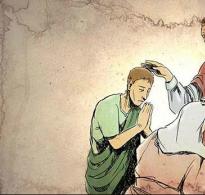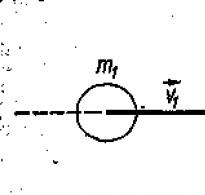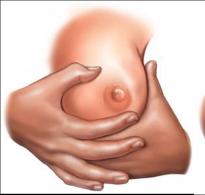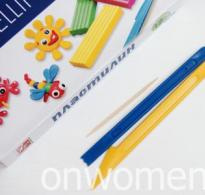How to make a Maya bee from scrap materials. DIY cotton bee. Footprint bee
Tatyana Bezmenova
Real vest
Striped shirt.
Only this is not a sailor,
And not the albatross bird,
This bee has dressed up
Got ready for work.
To the meadow, and to the flower,
Sweet collecting honey!
A. Teslenko
By publishing the script and photo report of the “Bee Kingdom” entertainment, I wanted to put an end to the materials on the “Where does honey come from” project. Indeed, a lot was done and shown, but the question after publishing the entertainment script - “What was this interesting thing that you hung from the ceiling at the holiday?”, prompted me to publish another material on this topic, namely, to talk about crafts from disposable cups made by children during the project.
I would like to offer you, dear friends and guests of my page, a master class on a craft with the simple name “Bee”. The works turned out to be bright, cheerful and really interesting, and most importantly, their production gave the children great pleasure. The stripes on the “body” of the bees were made by me from ordinary black electrical tape, but the older guys, I’m sure, will be able to cope with this task on their own.
The master class will be of interest to teachers working with children of different age groups.
Purpose.
Interior decoration. For children's free activity.
Target.
Making bees from disposable glasses.
Tasks.
Develop children's spatial understanding, the ability to place sequins throughout a given space without sticking to each other
Develop interest and positive attitude towards constructive activities
Enrich children's sensory experiences
Material.
Yellow plastic cups, black electrical tape, brightly colored paper, sequins, plasticine, Kinder surprise cases, glue stick, scissors.

Progress
We glue black electrical tape onto the disposable cup at a gap approximately equal to the width of the electrical tape.


Using plasticine, we attach a case from a Kinder surprise - a bee's head - to the top of the glass.

We make eyes, a mouth, and antennae from plasticine.

Cut out bee wings from brightly colored paper.

We decorate the wings with sequins using plasticine.


Now we glue the wings to the cup. The bee is ready.

In order to be able to hang the bees from the ceiling, we attach a brightly colored thread.

And now I want to show how my kids worked to create the craft, how much joy this work brought them.








Publications on the topic:
It's no secret that teachers prepare many attributes for doing things with their own hands, and there are several reasons for this - you want to do something.
The idea, of course, was taken from the Internet. But this is what we got! For work we will need the following materials and tools: Cups.
Master class on making a cup for pencils. Practical reason: Individual pencil cups are a must.
Winter is coming to an end. But as they say, the blizzards and blizzards arrived in February. Snowfall has not been canceled. And, apparently, succumbing to nostalgia.
Master Class. "Vase of disposable spoons." Mother's Day is coming soon. On the eve of this holiday I would like to congratulate everyone.
A cute decoration for the New Year made from disposable cups - Master class "HER-HER RING" This method of creating a festive craft is very popular.
Bee
We will need: threads of two colors (black and yellow), thick copper wire for beading, fluffy black thread, brown adhesive tape for beading, PVA glue, cardboard, scissors, gypsy needle and two pieces of fabric (white bow) size 10x5.
Step 1
Making the bee's abdomen. We cut out two rings from cardboard with an outer radius of 2 cm and an inner radius of 1 cm. Now we wrap these rings with threads of two colors (yellow and black) alternately. We begin to wind the yellow thread first, wrapping the rings with it only once, but at the same time, each turn must be arranged very tightly to each other. Then we begin to wind the black thread, we wrap it around the rings three times (that is, there should be three layers of black thread). Next, we wind the yellow thread again, also in three layers. And the last time, we wind the black thread in two or three layers. The number of layers of black thread in the latter case depends on how tightly the rings are wrapped and whether there is still room and opportunity left to pull the thread into the center of the ring. These rings must be wrapped so that there is no visible hole left in the center (it must be completely filled with threads).
There is such a feature in making pompoms: the tighter and tighter the rings are wrapped (the more threads there are), the more oval the pompom will be. If you need a round pom-pom, then when wrapping the rings, the thread should be arranged loosely, without tension, and a visible hole should remain in the center (that is, the central hole should not be completely filled with threads).
In our case, the bee's abdomen is oval, so we make an oval pompom. Having wrapped the rings well, we then proceed according to the scheme already known to us: we cut the threads along the outer edge with sharp scissors, tie them in the center with thread, remove the rings, and fluff them up. We cut off the irregularities on the surface of the finished pompom, as well as the thread that was used to tie it in the center.
Step 2
Making the bee's head.
We cut out two rings from cardboard with an outer radius of 1.5 cm and an inner radius of 0.7 cm. We wrap them with black thread, make the pompom round, so we leave a visible hole in the center. This pom pom will be pure black.
Step 3
Making a bee breast.
We cut out two rings from cardboard with an outer radius of 1.8 cm and an inner radius of 0.9 cm. We wrap them only with black thread. We make this pompom round.

Step 4
Making a bee's paws.
A bee has six legs. We cut two pieces of 11 cm each from thick copper wire (these are the front paws), two pieces of 10 cm each (these are the middle paws), two pieces of 12 cm each (these are the hind legs). We wrap each piece of wire with black fluffy thread only from one end, wrapping a little more than half the length of the wire. Leave the other end of the wire unwound. Now we stick all the paws in pairs into the bee’s chest. Front paws - one on the right, one on the left, twist the bare ends of the wire between the fibers of the pompom. Then we stick in the middle paws - we do the same. And the hind legs - we do the same thing (keeping in mind that the hind legs are the longest). All twisted ends of the wire should be in the lower part of the breast (as if under the breast), hidden among the fibers of the pompom.
Step 5
Glue three pom-poms with PVA glue in the following sequence: head, chest with paws, abdomen. We fix the glued bee between two objects and leave it for two to three hours so that the glue dries well.

Step 6
During this time we make wings. We cut two pieces of 22 cm from thick copper wire. From 17 cm we make the outline of the wing, and bend the remaining 5 cm at an angle of 90 degrees to the wing. This way we made a pin, which we will then simply stick into the bee’s chest. We coat the wire, which is the contour of the wing, with PVA glue, and while the glue is still wet, place a piece of fabric (white bow) measuring 10x5 cm on top of the glue. Let the glue dry well, then cut off the excess fabric-bow behind the contours of the wing. Now we stick the wings on both sides into the bee’s chest. The pins can be fixed at the bottom of the breast by twisting them together, or you can just stick them in and do nothing else.

Step 7
Bee sting.
Cut a piece 2 cm long from thick copper wire. Wrap it with brown or black adhesive tape, which is used for beading. Glue the sting at the back between the fibers of the pompom using PVA glue.
Step 8
Bee's antennae.
Cut two pieces of 2.5 cm each from thick copper wire. Wrap them in the same color as the tip (brown or black) with adhesive tape. Bend them into an “L” shape to create a corner with one end slightly longer than the other. We grease with PVA glue those ends of the corners that are shorter and glue them into the bee’s head on both sides. The long part of these corners should be directed downwards.

Unfortunately, errors are periodically found in articles; they are corrected, articles are supplemented, developed, and new ones are prepared. Subscribe to the news to stay informed.
How to knit the following patterns: Mountain peaks, autumn harmony. Detailed instructions...
Gas stove. Conversion to natural / liquefied, bottled gas. Stop...
How to convert a kitchen gas stove to another gas, swap burners, for...
Knitting. Openwork stained glass. Drawings. Pattern schemes...
How to knit the following patterns: Openwork stained glass. Detailed instructions with explanations...
Salt the mackerel. Selecting fish, salting, marinating...
How to salt mackerel. Pickling tips. Classic salting recipe. Salting in...
And you will learn about one of them below.
To create a bee with your own hands, you don't need a lot of tools and a lot of skills - use your imagination and simple instructions.
There are several ways to make a three-dimensional toy bee:
You will need:
- plastic bottle (0.33 l)
- scissors
- plastic cup
- glue
- acrylic paints
- tassels
- black electrical tape
- wire
- stationery knife.
1. Cut out bee wings from a plastic glass.

2. Using a utility knife, cut a small hole in the sides of the plastic bottle where you will insert the wings.
3. Insert the wings into the holes.



6. Draw an outline on the butterfly’s wings.

How to make a bee and a hive with your own hands

- plastic bottles (one with a capacity of 5 liters, and several bottles of 1 liter each - their number depends on the number of bees)
- yellow acrylic paint
- black electrical tape
- tassels
- glue gun or superglue
- plastic eyes and nose beads
- leg-split
- synthetic thread.
1. Prepare plastic bottles and paint them yellow.

2. Use electrical tape to create black stripes on the bottles.

3. Using a glue gun or superglue, glue the plastic eyes and nose onto the lid.

4. Prepare another plastic bottle and use scissors or a stationery knife to cut wings for the bees out of it.

5. Glue threads so that your toy bee can be hung on a tree, for example.


Creating a hive for bees
1. Prepare a 5-liter plastic bottle and cut a square hole in it.

2. Paint the bottle yellow - it is advisable to paint in several layers.
3. To make the roof of the hive, use tassels that need to be tied with twine.

4. Using glue, glue the brushes to the bottle cap. Add more glue if necessary.

Now you can decorate your garden plot or other room with crafts.
Read also:Beautiful DIY crafts made from natural materials

Plastic bee and cardboard hive



And you will learn about one of them below.
To create a bee with your own hands, you don't need to have a lot of tools or skills - use your imagination and simple instructions.
There are several ways to make a three-dimensional toy bee:
Bee made from plastic bottles
You will need:
Plastic bottle (0.33 l)
Scissors
Plastic cup
Acrylic paints
Tassels
Black electrical tape
Wire
Stationery knife.
1. Cut out bee wings from a plastic glass.

2. Using a utility knife, cut a small hole in the sides of the plastic bottle where you will insert the wings.
3. Insert the wings into the holes.

4. Start painting the bee. There are two ways: paint the bottle black and after it dries, paint yellow stripes, or paint the bottle yellow and then add black stripes.


5. On the bottle cap, paint the bee’s face with acrylic paints - use white to draw the eyes, and red paint for the mouth.
6. Draw an outline on the butterfly’s wings.

How to make a bee and a hive with your own hands

You will need:
Plastic bottles (one with a capacity of 5 liters, and several bottles of 1 liter each - their number depends on the number of bees)
Yellow acrylic paint
Black electrical tape
Tassels
Glue gun or superglue
Plastic eyes and nose beads
Synthetic thread.
1. Prepare plastic bottles and paint them yellow.

2. Use electrical tape to create black stripes on the bottles.

3. Using a glue gun or superglue, glue the plastic eyes and nose onto the lid.

4. Prepare another plastic bottle and use scissors or a stationery knife to cut wings for the bees out of it.

5. Glue threads so that your toy bee can be hung on a tree, for example.


6. Glue the wings with thread to the already painted bottle.
Creating a hive for bees
1. Prepare a 5-liter plastic bottle and cut a square hole in it.

2. Paint the bottle yellow - it is advisable to paint in several layers.
3. To make the roof of the hive, use tassels that need to be tied with twine.

4. Using glue, glue the brushes to the bottle cap. Add more glue if necessary.

Now you can decorate your garden plot or other room with crafts.

Plastic bee and cardboard hive



You can also find bees on the street. They were seen by adults and children on all continents, with the exception of Antarctica. The bees begin their work in the dazzling glare of the sun and finish it when it gets dark. Bees are the first insects from which humans began to benefit. Since ancient times, bees have been bred to produce wax, honey, propolis and other bee products. They are beautifully colored with yellow and black stripes. Let's make a master class today and make such a wonderful bee out of cotton wool with our own hands.
In order to create the “Bee” craft we will need:
1. Vata;
2. PVA glue;
3. Gouache, brushes;
4. Yellow waxed cord;
5. Scissors;
6. White cardboard;
7. White threads.
1. First we prepare the solution - dilute PVA glue with water to the consistency of milk, take a small lump, dip it into the solution, let the lump of cotton wool soak well. We form the body of a bee from wet cotton wool as in the photo and form a sting at the end of the body. The long side of the body should be approximately 2.2 cm. Then leave it to dry.
2. Now, in the same way, we form a ball with a diameter of approximately 1.3 cm, this will be the bee’s head. Leave to dry.


4. Paint all 6 resulting parts with yellow gouache.

5. Glue the head to the body with PVA glue and let it dry. Then, with a thin brush, paint three black stripes with gouache on the bee’s body.

6. Glue the legs to the body using PVA glue as in the photo.

7. Take a yellow wax cord and cut off pieces 7-8 mm long with scissors.

8. Glue the pieces onto the head with PVA glue in the same way as in the photo. These will be antennae.

9. Trim the antennae so that they are 4-5 mm long.

10. Using black gouache we draw the bee’s eyes in the same way as in the photo.

11. Use black gouache to draw a smile and eyelashes.

12. Using pink gouache, draw the cheeks of the bee.

13. Use white gouache to draw the pupils.

14. Now we need PVA glue with the consistency of thick sour cream; to get this consistency, pour PVA glue into a small container and leave for two hours until it thickens. Then dip the brush thickly in glue and apply a small amount to the antennae, as if forming balls as in the photo. After drying, repeat so that the balls are the same size as in the photo. Let the second layer dry.

15. Now we need white cardboard, on it we draw these wings, approximately 1.2 cm long, then cut out the wings.

16. Using black gouache we draw the edging and stripe on the wings as in the photo.

17. Apply thick PVA glue to the back, where the wings should be located, and glue the wings as in the photo. Hold the wings with your hands for a little while until the glue sets.

18. Take white threads and cut a 26 cm piece, fold it in half.

19. Apply thick PVA glue to the space between the wings and glue a thread there. Let it dry.

20. Our bee is ready.







